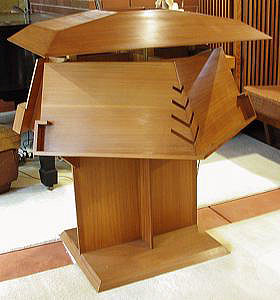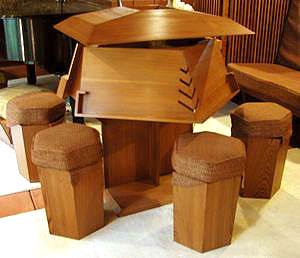Dr. Isadore and Lucille Zimmerman Residence, Manchester, NH (1950) (S.333)
I had the opportunity to view the interior of the home, but photography of the interior was not allowed.
The Music Stand photographs are Copyright of the Currier Museum of Art.(Note, due to the fact that the internet is constantly changing, and items that
are posted change, I have copied the text, but give all the credits available.)
Images By the Currier Museum of Art
1: Music Stand. 2: Music Stand with Stools. MUSIC STAND
By Hetty Startup
http://216.204.67.110/Obj8224$38When Wright designed a house he typically created much of the furniture as well. The Zimmerman House is no exception, and its music stand contributes significantly to the building's domestic aesthetic and sense of modernity. However, as was often the case with Wright's furniture, it was not always considered very practical and was not "too popular with the professional musicians" using it (1). Wright's approach to design was intended to embrace the lives of his clients in more ways than one, and in this case, he wanted to support the Zimmermans' love of music and their plans for modest entertaining. Of the six quartet stands that are Wright-designed that are known to exist (two are at Taliesin, Wright's home and school in Wisconsin, one is at his winter retreat and residence called Taliesin West, in Arizona, one is at the Dallas Public Library, and the sixth at the Lyndon Baines Johnson Library in Austin, Texas), the one in the Zimmerman House is a variation of the "design matured with a more structurally sound construction than its predecessors." (2)
The quartet stand is one of thirty-three pieces of furniture for the house. All of it was made of cypress and cypress veneer, a material Wright called "the wood eternal." He chose the same material for the home's interior walls and ceilings. Wright intended the music stand to form part of an integrated domestic space. Because he was also interested in organic forms that drew their inspiration from nature, the appearance of the music stand recalls that of an abstracted plant form. Rectangular in shape, it is also sculptural, and by far the most unusual piece of furniture in the room. The four facades of the stand contain ledges to hold sheet music. It is crowned with an ingenious, removable hood or tray with space for a small artwork, a plant or a vase of flowers. This hood also shades four small lights installed underneath the hood that help to illuminate the sheet music. Four stools accompany the stand. http://collections.currier.org/Obj8240${SessionID}, http://collections.currier.org/Obj8241${SessionID}, http://collections.currier.org/Obj8242${SessionID}, http://collections.currier.org/Obj8243${SessionID}
Like the rest of the furniture in the Zimmerman House, the music stand was constructed in a Manchester manufacturing company, under the supervision of John Geiger, Wright's on site apprentice. Like the five other Wright music stands in existence, drawings were not necessarily made; if a drawing was requested,
Wright often incorporated any necessary modifications in terms of wood choice, form and detailing. In a recent correspondence, John Geiger recalled, "_ [the music stand] seemed such a natural in that [garden] room silhouetted against the grand piano. It went through a development period and no drawing existed for its finished form. [After it was finished,] Joe Fabris [another Taliesin apprentice] made a drawing from the finished product specifically for the Zimmermans." (3)
Wright's first designs for such a music stand date from the early 1930s when he made two versions in oak veneer and Philippine mahogany for the living room at Taliesin and the playhouse of the Hillside Home School. These were used by family members and also by his apprentices, once Hillside had been converted to use as his educational setting for apprentices called the Taliesin Fellowship. In his autobiography Wright states that his living room at Taliesin - where the music stand was installed next to a grand piano - acted as a stimulus to the apprentices to think about good design; everything was to be experienced from here, from views of the sheep on the hills outside to the "house decorations" indoors. The presence at the Hillside Playhouse of professional musicians and accomplished players amongst the apprentices themselves - where the second music stand was installed - also spurred interest in these spaces as a setting for all kinds of classical and folk repertoire. (4)
Dr. and Mrs. Zimmerman left all of the furniture with the house and made its entire contents a gift to the Currier Museum of Art in 1988. If the Zimmerman House itself is one of the most unusual and significant objects in the museum's collection, the music stand is arguably the most important object in the Zimmerman House.
NOTES
1. Email from John Geiger, the Zimmerman House Wright-appointed apprentice, July 12th 2004 to Hetty Startup, Zimmerman House Site Administrator.
2. E-mail from Oscar Munoz, Frank Lloyd Wright Foundation Archives, July 9th 2004 to Hetty Startup, Zimmerman House Site Administrator.
3. Email from John Geiger to Hetty Startup, July 12th 2004.
4. Frank Lloyd Wright, An Autobiography (New York: Horizon Press, 1977.)BACK HOME ARTIFACTS AUDIO BOOKS PERIODICALS PHOTOS POSTCARDS POSTERS STAMPS STUDIES ASSISTING COLLECTING
©Copyright 2007

